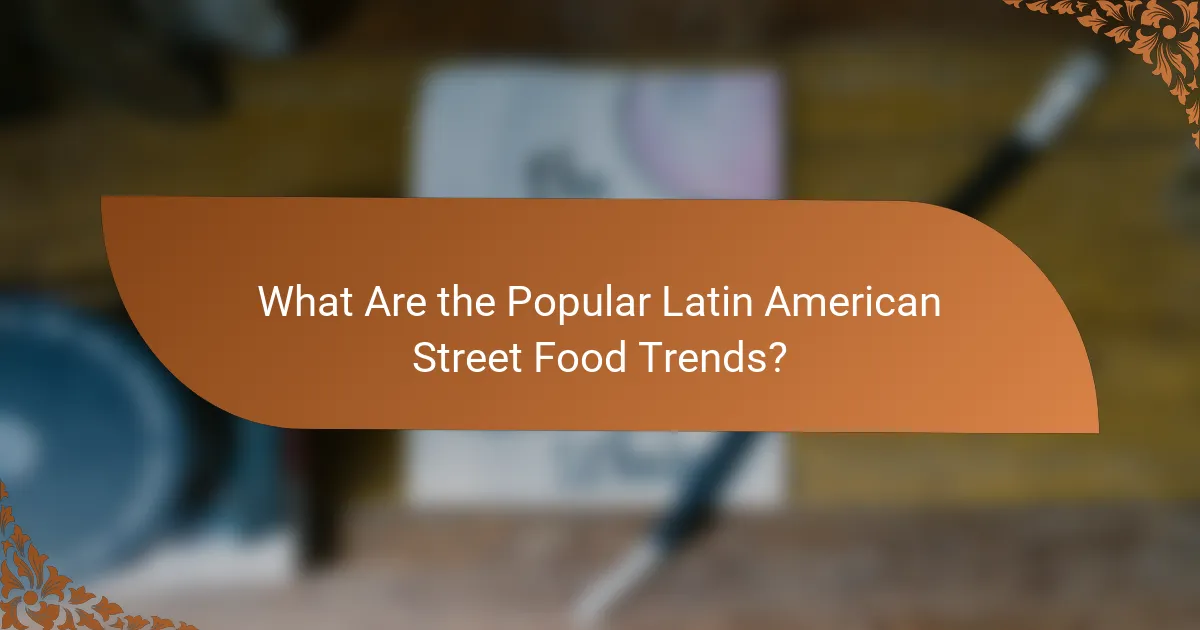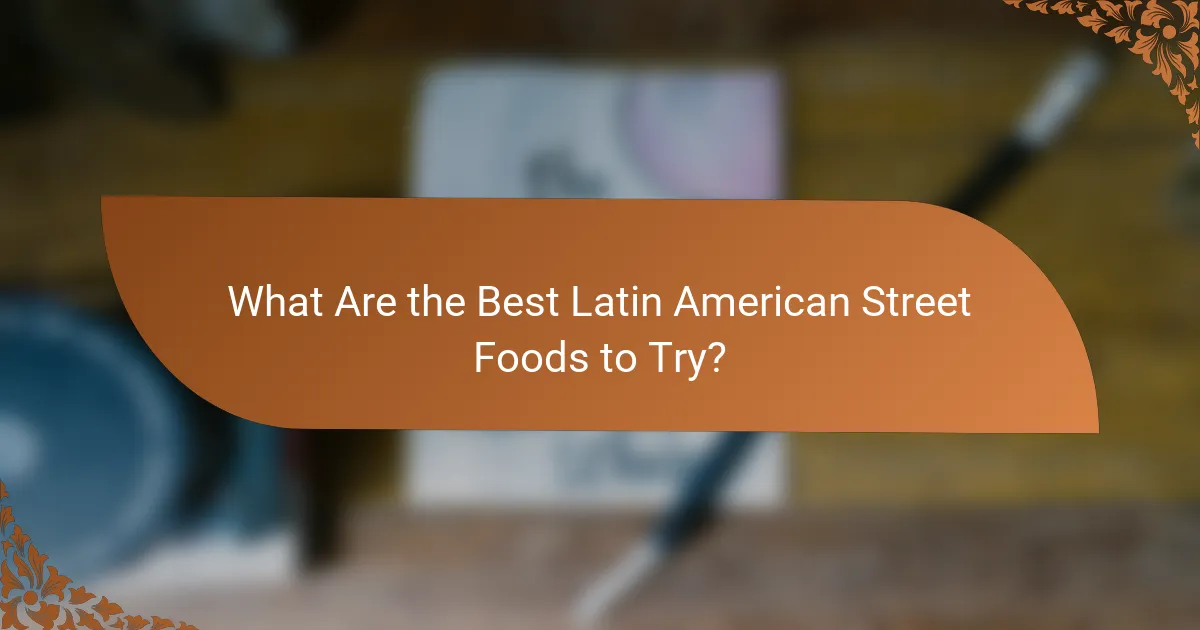Latin American street food is experiencing a dynamic evolution, merging traditional flavors with modern culinary innovations. This vibrant scene showcases a variety of dishes that highlight local ingredients and contemporary cooking techniques, all while celebrating the region’s rich culinary heritage. From Tacos al Pastor to Ceviche, each offering provides a unique taste experience that reflects the creativity and diversity of Latin American cuisine.

What Are the Popular Latin American Street Food Trends?
Popular Latin American street food trends reflect a blend of traditional flavors and modern culinary innovations. These trends emphasize creativity, health, and a growing appreciation for diverse ingredients and cooking styles.
Fusion Cuisine
Fusion cuisine combines elements from different culinary traditions, creating unique street food offerings. For example, tacos filled with Korean BBQ or sushi burritos are gaining popularity, showcasing how diverse flavors can come together in exciting ways.
Street vendors are experimenting with various cultural influences, often incorporating local ingredients to enhance authenticity. This trend appeals to adventurous eaters looking for new taste experiences.
Health-Conscious Options
Health-conscious street food options are becoming more prevalent as consumers seek nutritious alternatives. Vendors are now offering dishes made with whole grains, fresh vegetables, and lean proteins, catering to those who prioritize wellness.
Examples include quinoa bowls topped with grilled chicken or fish tacos served with cabbage slaw. These options not only taste great but also provide a healthier choice without sacrificing flavor.
Plant-Based Innovations
Plant-based innovations in street food are on the rise, driven by the increasing demand for vegetarian and vegan options. Vendors are creatively using ingredients like jackfruit, lentils, and chickpeas to create satisfying dishes that appeal to a broader audience.
Popular items include vegan arepas and plant-based empanadas, which offer traditional flavors while being entirely meat-free. This trend supports sustainability and caters to the growing number of consumers adopting plant-based diets.
Regional Specialties
Regional specialties highlight the diverse culinary heritage of Latin America, with street food reflecting local traditions and flavors. Each country boasts unique offerings, such as pupusas in El Salvador or arepas in Venezuela, showcasing the rich tapestry of Latin American cuisine.
Street vendors often take pride in their regional dishes, using family recipes passed down through generations. This focus on authenticity helps preserve cultural heritage while providing delicious food options.
Street Food Festivals
Street food festivals are increasingly popular, bringing together vendors from various regions to celebrate culinary diversity. These events allow attendees to sample a wide array of dishes, from traditional favorites to innovative creations.
Festivals often feature live music, cooking demonstrations, and competitions, creating a vibrant atmosphere. They serve as a platform for emerging chefs to showcase their talents and introduce new flavors to the public.

How Are Latin American Street Foods Innovating?
Latin American street foods are innovating by incorporating local ingredients, adopting modern cooking techniques, and embracing the food truck movement. These trends reflect a blend of traditional flavors with contemporary culinary practices, enhancing the overall dining experience.
Use of Local Ingredients
Street food vendors are increasingly sourcing ingredients from local farmers and markets, which not only supports the community but also enhances flavor and freshness. This practice allows for seasonal variations in menus, making dishes unique to specific regions.
For example, in Mexico, vendors might use locally grown corn for tortillas, while in Brazil, fresh tropical fruits can be found in juices and desserts. This focus on local produce helps maintain authenticity and reduces transportation costs.
Modern Cooking Techniques
Innovative cooking methods such as sous-vide, fermentation, and molecular gastronomy are making their way into street food. These techniques allow vendors to create complex flavors and textures that elevate traditional dishes.
For instance, some vendors are using sous-vide to prepare meats, ensuring they are tender and flavorful, while others experiment with fermentation to create unique sauces and toppings. This blend of old and new techniques attracts a broader audience and enhances the culinary landscape.
Food Truck Revolution
The food truck phenomenon has transformed the street food scene, offering mobility and flexibility to vendors. Food trucks can quickly adapt to trends and customer preferences, often featuring rotating menus that showcase seasonal ingredients.
In cities like Buenos Aires and São Paulo, food trucks serve gourmet versions of classic street foods, such as upscale arepas or artisanal empanadas. This trend not only provides diverse dining options but also fosters a sense of community through food festivals and gatherings.

What Are the Best Latin American Street Foods to Try?
Latin American street food offers a vibrant array of flavors and textures, with each dish reflecting the region’s rich culinary heritage. Some of the best street foods to try include Tacos al Pastor, Arepas, Ceviche, and Empanadas, each bringing unique tastes and experiences.
Tacos al Pastor
Tacos al Pastor are a popular Mexican street food made from marinated pork cooked on a vertical spit, similar to shawarma. The meat is typically seasoned with a blend of spices, including achiote, and served on soft corn tortillas.
When enjoying Tacos al Pastor, look for vendors who slice the meat fresh from the spit and offer a variety of toppings like onions, cilantro, and pineapple. A good taco should balance the savory meat with the freshness of the toppings.
Arepas
Arepas are a staple in Venezuelan and Colombian cuisine, made from ground maize dough that can be grilled, baked, or fried. These versatile pockets can be filled with a variety of ingredients, such as cheese, meats, or vegetables.
When trying Arepas, consider the different regional variations, such as the cheese-filled Arepa de Queso or the meat-stuffed Arepa Rumbera. They are often served with sauces like guasacaca or hogao, enhancing their flavor profile.
Ceviche
Ceviche is a refreshing dish made from raw fish or seafood marinated in citrus juices, typically lime, which “cooks” the fish. This dish is especially popular in coastal regions of Latin America, such as Peru and Ecuador.
When sampling Ceviche, pay attention to the freshness of the ingredients. It is commonly served with sides like sweet potato, corn, or plantain chips, which complement the acidity of the marinade.
Empanadas
Empanadas are stuffed pastries found throughout Latin America, with fillings ranging from meats and cheeses to vegetables and fruits. They can be baked or fried, offering a crispy exterior and a flavorful interior.
To enjoy Empanadas, look for those made with fresh dough and quality fillings. Popular variations include the Argentine beef empanada and the Chilean pino, which features a mix of meat, olives, and hard-boiled eggs. Pair them with a dipping sauce for added flavor.

Where Can You Find Authentic Latin American Street Food?
Authentic Latin American street food can be found in various vibrant settings, including local markets, food festivals, and from street vendors. Each of these venues offers a unique experience and a chance to taste traditional dishes that reflect the region’s diverse culinary heritage.
Local Markets
Local markets are prime spots for discovering authentic Latin American street food. These bustling hubs often feature a variety of food stalls where vendors sell homemade dishes, fresh produce, and local specialties. Markets like Mercado de San Juan in Mexico City or La Merced in Lima are known for their rich offerings.
When visiting a local market, look for stalls with long lines, as they often indicate popular and trusted vendors. Sampling small portions can help you explore different flavors without overwhelming your palate or budget.
Food Festivals
Food festivals celebrate the culinary diversity of Latin America and are excellent venues to find authentic street food. Events like the Festival de la Gastronomía in Peru or the Feria de la Gastronomía in Colombia showcase a wide range of traditional dishes prepared by local chefs and vendors.
Attending these festivals allows you to taste various foods in one location, often at reasonable prices. Be sure to check the festival schedule in advance, as many events occur annually and may feature special activities or competitions.
Street Vendors
Street vendors are a quintessential part of the Latin American culinary scene, offering a wide array of delicious and affordable options. From tacos in Mexico to arepas in Venezuela, these vendors often serve food made from family recipes passed down through generations.
When approaching street vendors, observe their cleanliness and the popularity of their offerings. Engaging with the vendor can also enhance your experience, as they may share stories about the dishes and their origins. Always carry small bills to make transactions easier.

How to Pair Drinks with Latin American Street Food?
Pairing drinks with Latin American street food enhances the overall dining experience by complementing flavors and textures. Consider the main ingredients and spices in the food to select beverages that balance or contrast these elements effectively.
Traditional Beverages
Traditional beverages play a crucial role in Latin American street food culture, often reflecting regional ingredients and culinary heritage. Popular choices include aguas frescas, horchata, and mate, each offering unique flavors that can enhance the food experience.
Aguas frescas, made from fruits, grains, or flowers mixed with water and sugar, are refreshing and versatile. For instance, a watermelon agua fresca pairs well with spicy tacos, while a hibiscus version complements savory tamales. Horchata, a creamy rice-based drink flavored with cinnamon, is excellent with fried foods like empanadas.
Another traditional option is mate, a caffeinated herbal tea popular in countries like Argentina and Uruguay. Its earthy flavor can balance rich dishes, making it a good match for grilled meats or hearty stews. When selecting drinks, consider the intensity and flavor profile of the food to create a harmonious pairing.
